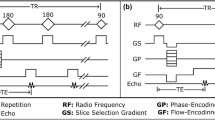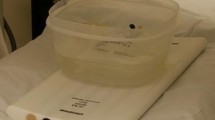Abstract
Objective
To evaluate the effect of metal artifact reduction techniques on dGEMRIC T1 calculation with surgical hardware present.
Materials and methods
We examined the effect of stainless-steel and titanium hardware on dGEMRIC T1 maps. We tested two strategies to reduce metal artifact in dGEMRIC: (1) saturation recovery (SR) instead of inversion recovery (IR) and (2) applying the metal artifact reduction sequence (MARS), in a gadolinium-doped agarose gel phantom and in vivo with titanium hardware. T1 maps were obtained using custom curve-fitting software and phantom ROIs were defined to compare conditions (metal, MARS, IR, SR).
Results
A large area of artifact appeared in phantom IR images with metal when TI ≤ 700 ms. IR maps with metal had additional artifact both in vivo and in the phantom (shifted null points, increased mean T1 (+151 % IR ROIartifact) and decreased mean inversion efficiency (f; 0.45 ROIartifact, versus 2 for perfect inversion)) compared to the SR maps (ROIartifact: +13 % T1 SR, 0.95 versus 1 for perfect excitation), however, SR produced noisier T1 maps than IR (phantom SNR: 118 SR, 212 IR). MARS subtly reduced the extent of artifact in the phantom (IR and SR).
Conclusions
dGEMRIC measurement in the presence of surgical hardware at 3T is possible with appropriately applied strategies. Measurements may work best in the presence of titanium and are severely limited with stainless steel. For regions near hardware where IR produces large artifacts making dGEMRIC analysis impossible, SR-MARS may allow dGEMRIC measurements. The position and size of the IR artifact is variable, and must be assessed for each implant/imaging set-up.







Similar content being viewed by others
References
Bashir A, Gray ML, Hartke J, Burstein D. Nondestructive imaging of human cartilage glycosaminoglycan concentration by MRI. Magn Reson Med. 1999;41:857–65.
Kurkijärvi JE, Nissi MJ, Kiviranta I, Jurvelin JS, Nieminen MT. Delayed gadolinium-enhanced MRI of cartilage (dGEMRIC) and T2 characteristics of human knee articular cartilage: topographical variation and relationships to mechanical properties. Magn Reson Med. 2004;52:41–6.
Burstein D, Velyvis J, Scott KT, Stock KW, Kim YJ, Jaramillo D, et al. Protocol issues for delayed Gd(DTPA)(2-)-enhanced MRI (dGEMRIC) for clinical evaluation of articular cartilage. Magn Reson Med. 2001;45:36–41.
Gillis A, Bashir A, McKeon B, Scheller A, Gray ML, Burstein D. Magnetic resonance imaging of relative glycosaminoglycan distribution in patients with autologous chondrocyte transplants. Invest Radiol. 2001;36:743–8.
Kurkijärvi JE, Mattila L, Ojala RO, Vasara AI, Jurvelin JS, Kiviranta I, et al. Evaluation of cartilage repair in the distal femur after autologous chondrocyte transplantation using T2 relaxation time and dGEMRIC. Osteoarthr Cart. 2007;15:372–8.
Tiderius CJ, Svensson J, Leander P, Ola T, Dahlberg L. dGEMRIC (delayed gadolinium-enhanced MRI of cartilage) indicates adaptive capacity of human knee cartilage. Magn Reson Med. 2004;51:286–90.
Roos EM, Dahlberg L. Positive effects of moderate exercise on glycosaminoglycan content in knee cartilage: a four-month, randomized, controlled trial in patients at risk of osteoarthritis. Arthritis Rheum. 2005;52:3507–14.
Williams A, Sharma L, McKenzie CA, Prasad PV, Burstein D. Delayed gadolinium-enhanced magnetic resonance imaging of cartilage in knee osteoarthritis: findings at different radiographic stages of disease and relationship to malalignment. Arthritis Rheum. 2005;52:3528–35.
Nojiri T, Watanabe N, Namura T, Narita W, Ikoma K, Suginoshita T, et al. Utility of delayed gadolinium-enhanced MRI (dGEMRIC) for qualitative evaluation of articular cartilage of patellofemoral joint. Knee Surg Sports Traumatol Arthrosc. 2006;14:718–23.
Tiderius CJ, Olsson LE, Nyquist F, Dahlberg L. Cartilage glycosaminoglycan loss in the acute phase after an anterior cruciate ligament injury: delayed gadolinium-enhanced magnetic resonance imaging of cartilage and synovial fluid analysis. Arthritis Rheum. 2005;52:120–7.
Owman H, Tiderius CJ, Neuman P, Nyquist F, Dahlberg LE. Association between findings on delayed gadolinium-enhanced magnetic resonance imaging of cartilage and future knee osteoarthritis. Arthritis Rheum. 2008;58:1727–30.
Tiderius CJ, Olsson LE, Leander P, Ekberg O, Dahlberg L. Delayed gadolinium-enhanced MRI of cartilage (dGEMRIC) in early knee osteoarthritis. Magn Reson Med. 2003;49:488–92.
Yamashita T, Watanabe A, Ochiai S, Matsuki K, Kamikawa K, Toyone T, et al. Time course evaluation of extracellular matrix after high tibial osteotomy using delayed gadolinium enhanced MR imaging of cartilage. Osteoarthritis Research Society International; 2008. p. Abstract 415.
Young AA, Stanwell P, Williams A, Rohrsheim JA, Parker DA, Giuffre B, et al. Glycosaminoglycan content of knee cartilage following posterior cruciate ligament rupture demonstrated by delayed gadolinium-enhanced magnetic resonance imaging of cartilage (dGEMRIC). J Bone Joint Surg Am. 2005;87-A:2763–8.
Parker DA, Beatty KT, Giuffre B, Scholes CJ, Coolican MRJ. Articular cartilage changes in patients with osteoarthritis after osteotomy. Am J Sports Med. 2011;39:1039–45.
Rutgers M, Bartels LW, Tsuchida AI, Castelein RM, Dhert WJ, Vincken KL, et al. dGEMRIC as a tool for measuring changes in cartilage quality following high tibial osteotomy: a feasibility study. Osteoarthr Cart Elsevier Ltd. 2012;20:1134–41.
Kolind SH, MacKay AL, Munk PL, Xiang QS. Quantitative evaluation of metal artifact reduction techniques. J Magn Reson Imaging. 2004;20:487–95.
Chang SD, Lee MJ, Munk PL, Janzen DL, MacKay A, Xiang QS. MRI of spinal hardware: comparison of conventional T1-weighted sequence with a new metal artifact reduction sequence. Skelet Radiol. 2001;30:213–8.
Lee MJ, Janzen DL, Munk PL, MacKay A, Xiang QS, McGowen A. Quantitative assessment of an MR technique for reducing metal artifact: application to spin-echo imaging in a phantom. Skelet Radiol. 2001;30:398–401.
Olsen RV, Munk PL, Lee MJ, Janzen DL, MacKay AL, Xiang Q-S, et al. Metal artifact reduction sequence: early clinical applications. Radiographics. 2000;20:699–712.
Norris D. Adiabatic radiofrequency pulse forms in biomedical nuclear magnetic resonance. Concepts Magn Reson. 2002;14:89–101.
Kim YJ, Jaramillo D, Millis MB, Gray ML, Burstein D. Assessment of early osteoarthritis in hip dysplasia with delayed gadolinium-enhanced magnetic resonance imaging of cartilage. J Bone Joint Surg Am. 2003;85-A:1987–92.
Cho ZH, Kim DJ, Kim YK. Total inhomogeneity correction including chemical shifts and susceptibility by view angle tilting. Med Phys. 1988;15:7–11.
McKenzie CA, Williams A, Prasad PV, Burstein D. Three-dimensional delayed gadolinium-enhanced MRI of cartilage (dGEMRIC) at 1.5 T and 3.0 T. J Magn Reson Imaging. 2006;24:928–33.
White LM, Buckwalter KA. Technical considerations: CT and MR imaging in the postoperative orthopedic patient. Semin Musculoskelet Radiol. 2002;6:5–17.
Eustace S, Goldberg R, Williamson D, Melhem ER, Oladipo O, Yucel EK, et al. MR imaging of soft tissues adjacent to orthopaedic hardware: techniques to minimize susceptibility artefact. Clin Radiol. 1997;52:589–94.
Lee M, Kim S, Lee S, Song H, Huh Y, Kim D, et al. Overcoming artifacts from metallic orthopedic implants at high-field-strength MR imaging and multi-detector CT. Radiographics. 2007;27:791–804.
Harris CA, White LM. Metal artifact reduction in musculoskeletal magnetic resonance imaging. Orthop Clin North Am. 2006;37:349–59. vi.
Suh JS, Jeong EK, Shin KH, Cho JH, Na JB, Kim DH, et al. Minimizing artifacts caused by metallic implants at MR imaging: experimental and clinical studies. AJR Am J Roentgenol. 1998;171:1207–13.
Laakman RW, Kaufman B, Han JS, Nelson AD, Clampitt M, O’Block AM, et al. MR imaging in patients with metallic implants. Radiology. 1985;157:711–4.
Koch KM, Busse RF, Lewein TA, Potter HG, Hinks RS, King KF. Multiple resonant frequency offset acquisitions for imaging of metallic implants. Toronto: The International Society for Magnetic Resonance in Medicine; 2008. p. 1250.
Lu W, Pauly KB, Gold GE, Pauly JM, Hargreaves BA. SEMAC: Slice encoding for metal artifact correction in MRI. Magn Reson Med. 2009;62:66–76.
Acknowledgments
This study was supported by a Canadian Institutes for Health Research (CIHR) Operating grant, a Natural Sciences and Engineering Research Council (NSERC) Collaborative Health Research Projects grant, a Michael Smith Foundation Trainee Award (AGD), a Natural Sciences and Engineering Research Council (NSERC) Post Graduate Fellowship (AGD), and a Canadian Arthritis Network Scholarship (DRW).
Conflict of interest
The authors declare that they have no conflicts of interest.
Author information
Authors and Affiliations
Corresponding author
Rights and permissions
About this article
Cite this article
d’Entremont, A.G., Kolind, S.H., Mädler, B. et al. Using the dGEMRIC technique to evaluate cartilage health in the presence of surgical hardware at 3T: comparison of inversion recovery and saturation recovery approaches. Skeletal Radiol 43, 331–344 (2014). https://doi.org/10.1007/s00256-013-1777-2
Received:
Revised:
Accepted:
Published:
Issue Date:
DOI: https://doi.org/10.1007/s00256-013-1777-2




